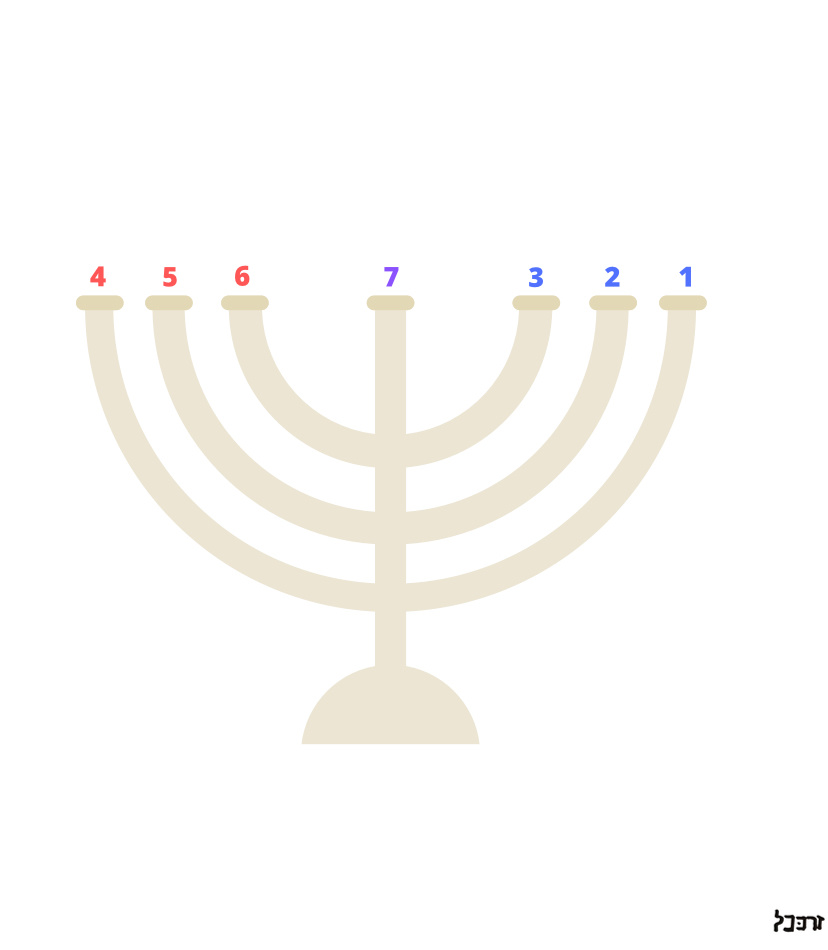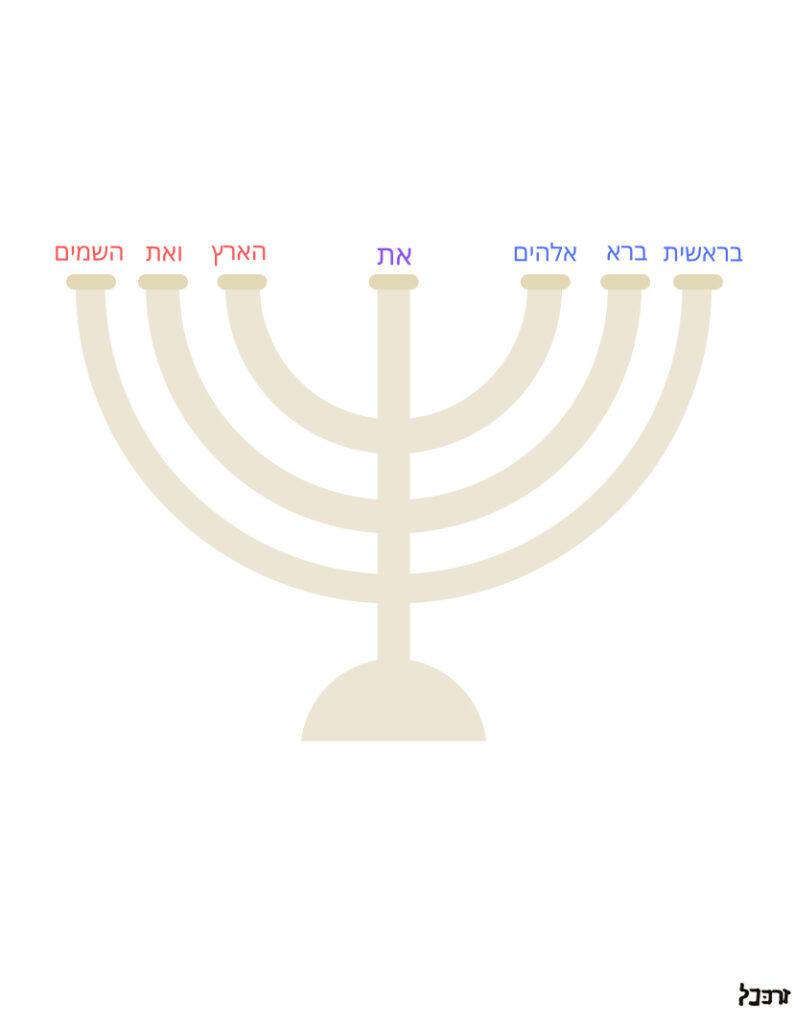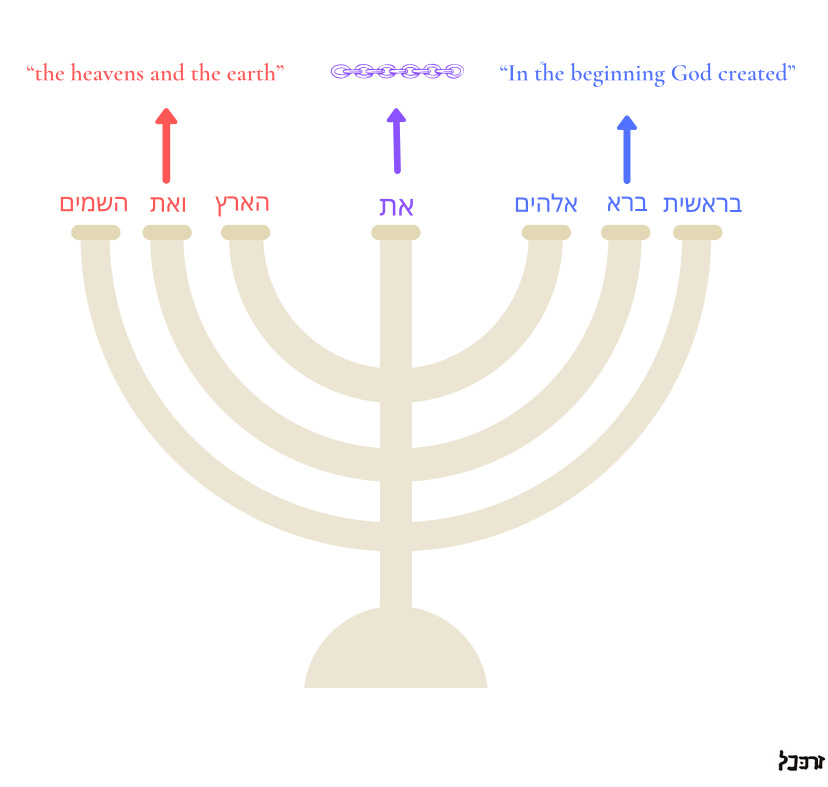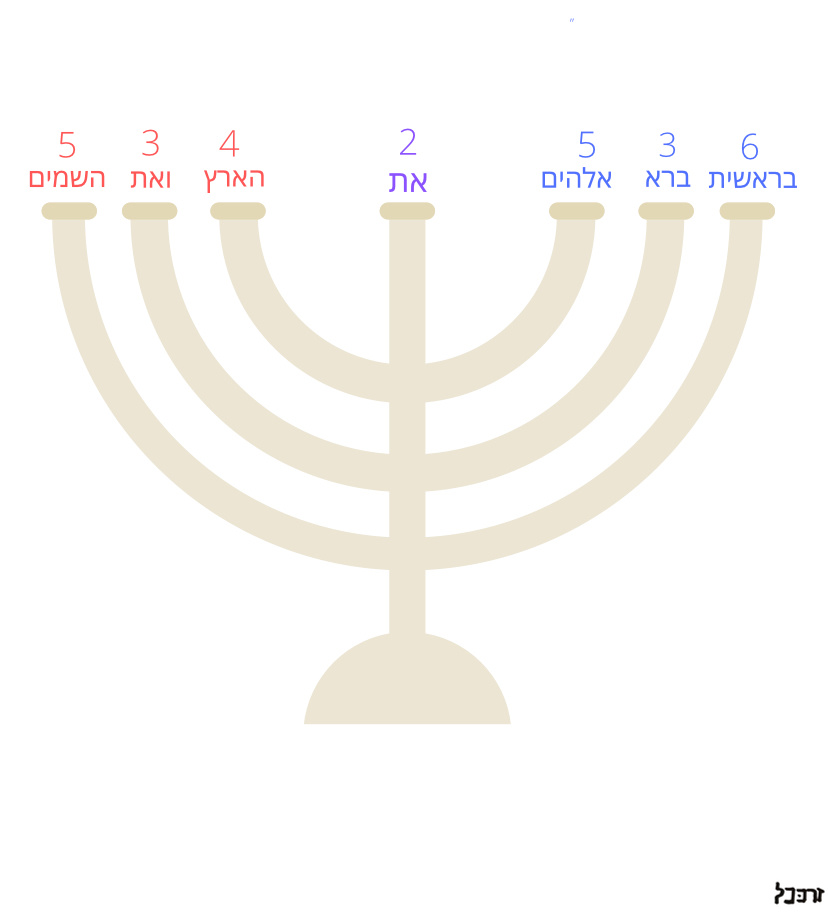The English Bible opens with the words: “In the beginning God created the heavens and the earth.” While there is a total of ten words in this sentence in English translation—in the original Hebrew text there are only seven. The seven Hebrew words of Genesis 1:1 are as follows:
| # | Word | Part of Speech | Translation |
| 1. | בְּרֵאשִׁית | Feminine noun | “In the beginning” |
| 2. | בָּרָא | Verb | “created” |
| 3. | אֱלֹהִים | Masculine noun | “God” |
| 4. | אֵת | Particle | [does not translate] |
| 5. | הַשָּׁמַיִם | Masculine noun | “the heavens” |
| 6. | וְאֵת | Particle/conjunction | “and” |
| 7. | הָאָֽרֶץ | Feminine noun | “the earth” |
As we will see shortly, the seven Hebrew words of Genesis 1:1 have been deliberately modeled according to the pattern of the golden candlestick (Exod. 25:31-40). Accordingly, it is necessary that we acquaint ourselves with the general pattern of the golden candlestick and the meticulous numbering system of its seven lamps, as this very meticulous design is intimately bound up with the mystery of the seven Hebrew words of Genesis 1:1.
The 3-1-3 pattern and the numbers of the seven lamps
The golden candlestick had a total of seven lamps. One lamp resided on the central shaft; the other six resided on the six outer branches which extended out from the central shaft (three on each side). I have created the figure below to show how the seven arms of the golden candlestick were numbered:

Note that I have deliberately colored the numbers in the figure above in order to help convey an important mystical truth about the golden candlestick’s design, pertaining to what I refer to as the “3-1-3 pattern.” Simply put–the three branches to the right of the shaft are of one likeness, while the three branches to the left of the shaft are of one likeness. The branches on the left and the branches on the right are antithetical yet complimentary to one another (like male and female). The central shaft is a perfect hybrid of the two opposing yet complimentary sides that it joins together into one body, and it is therefore colored purple to convey this blended nature (blue + red = purple).1 This very meticulous pattern and peculiar numbering system will begin to make a lot more sense when we start to examine the seven days of creation in a future discussion.
Another important thing to understand about the golden candlestick (which should be evident from the image above) is that the branches operate in pairs–each pair being united together as one by the central shaft. The three pairs of branches are self-evident–branches 1 & 4 constitute a pair, branches 2 & 5 constitute a pair, and branches 3 & 6 constitute a pair. As previously stated, the branches on the left and the branches on the right of the shaft are of opposite natures, which means that the two members of any given pair of branches are both antithetical yet complimentary to one another in nature.2 For illustrative purposes we might revert to our previous male & female analogy and liken them unto married couples—with the branch to the right of the shaft representing the male nature, and the branch to the left of the shaft representing the female nature.
The seven Hebrew words of Genesis 1:1 & the golden candlestick
Now that we have that out of the way, let us look at how the seven words of Genesis 1:1 conform perfectly to this pattern:

Here it is in tabular form (with English translation):

One will immediately note that the seven Hebrew words of Genesis 1:1 are not arranged in this pattern as one would naturally expect, that is–according to their word order. Indeed, it is the fourth word of the sentence–the Hebrew particle אֵת, who is entirely to blame for this deviation from the expected arrangement of the seven words on the seven lamps, for it occupies the column corresponding to lamp 7 (rather than lamp 4) of the candlestick. What might be the reason for this?
Of the seven Hebrew words of Genesis 1:1, אֵת stands alone as the odd man out in the verse. It should first be noted that this word isn’t really a “word” at all, but rather an accusative particle which in the Hebrew tongue precedes a definite direct object that is receiving or being affected by the action of a particular verb which precedes it (in this case bara (“created”)).3 As such, this is the only word in the sentence that has no meaning by itself and therefore does not translate. And because it is not technically a “word”, it does not get counted as a word (just as the shaft is not a branch and does not get counted with the other branches). Accordingly, הַשָּׁמַיִם (“the heavens”) is the true fourth word of the sentence, and it therefore appears on lamp #4.
Note that just as the central shaft functions as what we might call a “joiner,” in that it joins the three branches on either side of it together as one unified candlestick–so too the accusative particle אֵת (which just so happens to be situated right smack dab in the middle of the verse), functions as a joiner which unifies the former half of the sentence (containing the subject and transitive verb) with the latter half of the sentence (containing the direct objects). The end result is one unified meaningful statement:

Taken together, it is blatantly obvious that the אֵת particle corresponds to the central shaft of the golden candlestick. Just as the shaft is the only arm of the candlestick that isn’t a branch, so too the אֵת particle is the only Hebrew “word” of the verse that isn’t actually a word. Likewise, just as the shaft of the candlestick joins the six branches together and makes them one unified candlestick–so too the אֵת particle joins the six Hebrew words together and makes them one unified verse.
Note also that the opposing yet complimentary natures of the branches to the left of the shaft and the branches to the right of the shaft is reflected in the grammatical function of the three words to the left of the אֵת particle and the three words to the right of the אֵת particle. The three words corresponding to lamps 1, 2, and 3 of the candlestick tell us what God did and when he did it (“In the beginning God created”), while the three words corresponding to lamps 4, 5, and 6 tell us specifically what he created (“the heavens and the earth”).4 Here yet again, we can see the design of the golden candlestick being reflected in the grammatical structure of the verse. Just as the central shaft unites the three branches on the left with the three branches on the right and fills them with pure olive oil, so too the accusative particle unites the three words on the left with the three words on the right and brings them to life as one unified living statement.
The 4-3 divisional schema of the golden candlestick & the seven Hebrew words of Genesis 1:1
There is one final thing I want to discuss about the golden candlestick in relation to the seven Hebrew words of Genesis 1:1. This pertains to the 4-3 divisional schema which multiple books of the Bible testify was inherent to the golden candlestick’s design. This is a subject that I will discuss at much greater length in a future discussion. However, because it is directly relevant to the mystery of the seven Hebrew words of Genesis 1:1, I want to go ahead at least give a bare bones introduction to this very important mystery regarding the golden candlestick’s design.
Multiple biblical witnesses attest that the seven arms of the golden candlestick were designed according to a meticulous 4-3 divisional schema.5 As a matter of fact, this 4-3 divisional schema is in fact visibly discernible when the seven Hebrew words are ordered according to their assigned lamps. Behold:

As the arrows in the top column of the above table testify, the first four words of the verse (corresponding to lamps 1, 2, 3 and 7 of the candlestick) flow according to their natural Hebrew right-left orientation. In contrast, the Hebrew words corresponding to lamps 4, 5, and 6 (although the individual words read from right to left) move against their natural right-left orientation. Accordingly, if we begin at lamp #1 and try to read all seven Hebrew words in a continuous right to left sequence, everything would be fine until we got beyond the shaft, at which point it would appear as if the last three words of the verse were read in the reverse order (“the earth and the heavens,” rather than “the heavens and the earth”). It is thus as if the words corresponding to lamps 1, 2, 3, and 7 are flowing in accordance with their natural orientation, while the words corresponding to lamps 4, 5, and 6 have been “grafted in” to the opposite side of the golden candlestick contrary to their nature (Rom. 11:24).
As we can clearly see here, when arranged according to their assigned lamps—the seven Hebrew words of Genesis 1:1 testify of the 4-3 divisional schema that is inherent to the golden candlestick’s design. Although the shaft stands completely apart from and is incomparable to any of the six branches that it unites, and is a perfect equal blend of the two antithetical yet complimentary natures of both sides, (as signified by its purple color)—in the 4-3 divisional schema it always gets counted with branches 1, 2, and 3.
Note that when the golden candlestick is divided according to the above 4-3 divisional schema, we find that the first three branches plus the shaft constitutes 57.1428571% (4 / 7 = 0.571428571) of the entire beaten work; while the remaining three branches constitute 42.857143% of the entire beaten work (3 / 7 = 0.42857143). What is significant about that? Well, there are a total of 28 letters in the seven Hebrew words of Genesis 1:1. When the seven words are arranged according to their seven lamps, we just so happen to get these exact same percentages when we divide the verse by the total number letters in the words corresponding to their lamps, as we do when we divide the golden candlestick by its lamps. Behold:

As can be seen, there are a total of 16 letters in the four words corresponding lamps 1, 2, 3, and 7; while there are a total of 12 letters in the three words corresponding to lamps 4, 5, and 6. This means that the four words corresponding to lamps 1, 2, 3, and 7 contain exactly 57.1428571% of all the letters in the verse (16 / 28 = 0.571428571), while the three words corresponding to lamps 4, 5, and 6 contain exactly 42.857143% (12 / 28 = 0.42857143) of all of the letters in the verse. Obviously, this could not have been a coincidence, and it further proves that the seven Hebrew words of Genesis 1:1 have been divinely patterned according to the seven arms of the golden candlestick. Not only that, but it provides yet another witness which affirms that the 4-3 divisional schema is inherent to the candlestick’s design. As we will see when we begin to discuss the golden candlestick and its relation to the biblical canon, this 4-3 divisional schema attested here will have enormous ramifications with regard to the symbolic and prophetic significance of the golden candlestick.
Conclusion
In this lesson we have seen how the seven Hebrew words of Genesis 1:1 have been deliberately modeled in the likeness of the golden candlestick. We also touched very briefly on the 4-3 divisional schema that was inherent to the candlestick’s design. Although this mystery may seem trivial, it is actually extremely important as it is deeply intertwined with numerous other biblical mysteries which are also tied to the design of the golden candlestick. Indeed, the mystery of Genesis 1:1 will take on a whole new level of significance and make a lot more sense once we start to get into the seven days of creation in a future lesson.
 Copyright secured by Digiprove © 2021 Zerubbabel
Copyright secured by Digiprove © 2021 Zerubbabel- Many of you will likely note that this same color scheme is present in other images on this blog, (including the design of the Behold the Stone logo), yet with the colors depicted in the reversed direction–with blue on the left, and red on the right. I realize that this is likely to cause some confusion, so I want to take a moment to clarify the reason for this. The orientation of the colors in the BTS logo is actually the “correct” orientation, that is–blue on the left and red on the right. However, this the color scheme is always going to be reversed any time we are dealing with a pattern of seven from the Bible that God has deliberately modeled in the likeness of the golden candlestick. The simple reason for this is just because the Hebrew language runs from right to left. Thus whereas we Westerners mentally associate “the beginning” with left and “the end” with right, for those who speak Hebrew it’s the opposite. In addition to that, however, there is also multifaceted symbolic meaning here that I wasn’t even aware of when I made these images. As one example, the golden candlestick is ultimately a symbol of Jesus Christ, who is the “Light of the World.” When the golden candlestick is viewed as a symbol of Jesus Christ–the three arms on the right would correspond to the left side of Jesus, while the three arms on the left would correspond to the right side of Jesus. Thus although from our perspective the colors appear to be oriented the opposite of how they should be, from his perspective they are oriented correctly. In addition to that, the golden candlestick is also a symbol of the Holy Bible–which is the Law (Written Word) of God. What is significant about that is that the Law of God functions first and foremost as a mirror which shows man how inherently sinful he is (Jas. 1:23). And of course we know that when one looks in the mirror, right appears left; and left appears right. In other words, the reversed orientation of the colors when depicted on the golden candlestick has even more symbolic significance in that it symbolically depicts the Holy Bible (symbolized by the golden candlestick) as a divinely given mirror through which man sees himself as inherently sinful, alienated from his Creator, without hope, and in desperate need of a Savior.
- This truth is also reflected by the fact that each pair of branches contains both an even number and an odd number
- Thus for example, in the sentence: “Jacob shot the rifle”, Jacob (the subject) is imparting an action (shooting). Note that “the rifle” is being affected by the action of the verb (“the rifle”). This is what is known as a direct object. A direct object can be either definite (“the rifle”) or indefinite (“a rifle”). In this example sentence, the rifle is a definite direct object. In Hebrew, any time you have a grammatical clause with a transitive verb and a definite direct object like this, the grammatical particle אֵת appears between the verb and the definite direct object. It is just one of those little grammatical rules that is unique to the Hebrew language, and therefore this word does not translate.
- It should also be pointed out that the three words corresponding to lamps 1, 2, and 3 are essentially “dead” without the three words corresponding to lamps 4, 5, and 6. Put another way, it’s as if the latter three words bring the former three words to life, in that they give them meaning and purpose.
- This divisional schema is not directly attested in the description of the golden candlestick found in Exodus 25:31-40, yet is attested by multiple other biblical witnesses–including (as we are about to see) the seven Hebrew words of Genesis 1:1. We will look at other examples in great detail in a future discussion.

Do you have Genesis 1:1 in paper/book format? I prefer reading off paper than computer screen. Thank you.
GOD=7_4: G is the 7th letter, a Circle O=15 or zer0 or an Operation, D=4.
GOD=7_4, 7/4=July 4th or 7 April (30 AD: GOOD Friday)
All the ancients observed the sacred 7 Luminaires/7 Classical Planets: Moon, Mercurcy, Venus, Sun, Mars, Jupiter, and Saturn. 4 of these can’t be seen during the day/4 don’t cast shadows on Earth (Venus can), There are 4 primary lunar phases of roughly 7 days (~7.4 days) each, thus the 7-day week and 4 weeks in a ‘moonth’. Lunar year of 354 days + 7 day week + 4 days = solar year of 365 days. Roman Calendar’s 7 thirty-one day months + 4 thirty day mo. + February’s 28 (7×4).
Orion is 7 stars with 4 being his shoulders & feet. Big Dipper & Little Dipper are both 7 stars with 4 in the bowl. The Pleaides/7 Sisters is the 4th most recognizeable asterism.
“As Above, So Below” – precept of ancient sacred geometry
Common cubits are 6 palms x 4 fingers = 24 digits
Royal cubits are 7 palms x 4 fingers = 28 digits
The ancient Sumerians, Egyptians and Israelites all used royal cubits to build their sacred structures.
Genasis 1:1 in its original Hebrew is 7 words and 28 (7×4) letters – it’s God’s Signature! The menorah has 7 lamps to symbolize the sacred 7 Luminaires. There’s a middle post and 3 connected branches, thus 7 lamps and 4 branches.
GOD=7_4
GOOD Friday=74=G7+O+O+D4 + F6+R18+I9+D4+A1+Y25
shadows=74=S19+H8+A1+D4+O+W23+S19
months=74=M13+O+N14+T20+H8+S19
cubits=74=C3+U21+B2+I9+T20+S19
Genasis=74=G7+E5+N14+A1+S19+I9+S19
menorah=74=M13+E5+N14+O15+R18+A1+H8
Jesus=74=J10+E5+S19+U21+S19
This is the secret Kaballa(7,40) reason for writing G-D.
Do you agree with kabbalah teachings. Like the 10 emanations, me personally I detest them
I was hoping to read this in full and study the original days of creation in full, I believe when read it explains all the truths completely truthfully about everything we all desire, what was, what has and what will be, past present and future is clearly detailed and explained clearly in the first book of god obviously things changed the had too and will again. I knew of this as a child, I sinned with the knowledge through my life and believe I’m nearing ready at the age of 55
Are not those 2 letters you call untranslatable ‘alef and Tav”? Yahshua said He was the alef and tav the first and the last as letters of the alefbet. Hebrew Alphabet
Hello Sandra,
Those letters are indeed aleph and tav. Jesus said that he was the alpha and omega (Rev. 1:8; 1:11; 21:6; 22:13), which are the first and last letters of the Greek alphabet, by which he simply meant that he is the first as well as the last (Rev. 1:11, 1:17, 2:8, 2:19, 22:13; cf. Isa. 44:6, 48:12). He never said that he was the aleph-tav, although I’m sure the same logic of this statement would still apply.
When I said that the Hebrew particle את is untranslatable I meant in a grammatical sense, as I was referring to the definite direct object marker that is formed by those two letters. This particle has no meaning by itself and therefore does not translate. Its function within the sentence is strictly grammatical in nature. I am not ruling out the possibility of some level of divinely intended, hidden symbolic meaning being potentially signified by the two letters, if that’s what you were implying.
Just out of curiosity, where did you get the name “Yahshua” from? Jesus’ name in Hebrew is Yeshua (ישוע), which is a shortened form of the name Yehoshua (יהושוע). No where in the Bible is Jesus referred to as “Yahshua.”
This also crossed my mind while reading this article (thanks for writing it, by the way!). I think there’s reason to believe that the book of Revelation was given to John in Hebrew, in which case Christ would have used the words “aleph” and “tav.”
He speaks these words while standing amid the lampstands, which John might have understood as a reference to what you described in this article (I assume first-century Jews were well aware of the structure of Genesis 1).
The ramifications of this idea, if true, are profound.
Yes it is, and with that knowledge we get a far more complete picture.